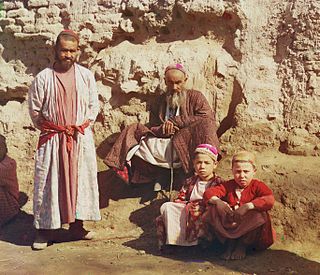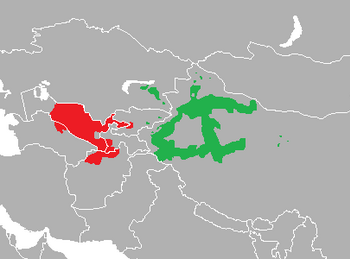
The Turkic languages are a language family of more than 35 documented languages, spoken by the Turkic peoples of Eurasia from Eastern Europe and Southern Europe to Central Asia, East Asia, North Asia (Siberia), and West Asia. The Turkic languages originated in a region of East Asia spanning from Mongolia to Northwest China, where Proto-Turkic is thought to have been spoken, from where they expanded to Central Asia and farther west during the first millennium. They are characterized as a dialect continuum.

The Turkic peoples are a collection of diverse ethnic groups of West, Central, East, and North Asia as well as parts of Europe, who speak Turkic languages.

The Tatars, formerly also spelt Tartars, is an umbrella term for different Turkic ethnic groups bearing the name "Tatar" across Eastern Europe and Asia. Initially, the ethnonym Tatar possibly referred to the Tatar confederation. That confederation was eventually incorporated into the Mongol Empire when Genghis Khan conquered the various steppe tribes. Historically, the term Tatars was applied to anyone originating from the vast Northern and Central Asian landmass then known as Tartary, a term which was also conflated with the Mongol Empire itself. More recently, however, the term has come to refer more narrowly to related ethnic groups who refer to themselves as Tatars or who speak languages that are commonly referred to as Tatar.

Kazakh or Qazaq is a Turkic language of the Kipchak branch spoken in Central Asia by Kazakhs. It is closely related to Nogai, Kyrgyz and Karakalpak. It is the official language of Kazakhstan and a significant minority language in the Ili Kazakh Autonomous Prefecture in Xinjiang, north-western China and in the Bayan-Ölgii Province of western Mongolia. The language is also spoken by many ethnic Kazakhs throughout the former Soviet Union, Germany, and Turkey.

Uzbek, formerly known as Turki, is a Karluk Turkic language spoken by Uzbeks. It is the official and national language of Uzbekistan and formally succeeded Chagatai, an earlier Karluk language also known as "Turki", as the literary language of Uzbekistan in the 1920s.

Tatar is a Turkic language spoken by the Volga Tatars mainly located in modern Tatarstan, as well as Siberia. It should not be confused with Crimean Tatar or Siberian Tatar, which are closely related but belong to different subgroups of the Kipchak languages.

Azerbaijani or Azeri, also referred to as Azeri Turkic or Azeri Turkish, is a Turkic language from the Oghuz sub-branch. It is spoken primarily by the Azerbaijani people, who live mainly in the Republic of Azerbaijan where the North Azerbaijani variety is spoken, and in the Azerbaijan region of Iran, where the South Azerbaijani variety is spoken. North Azerbaijani has official status in the Republic of Azerbaijan and Dagestan, but South Azerbaijani does not have official status in Iran, where the majority of Azerbaijani people live. Azerbaijani language is also spoken to lesser varying degrees in Azerbaijani communities of Georgia and Turkey and by diaspora communities, primarily in Europe and North America.

Chagatai, also known as Turki, Eastern Turkic, or Chagatai Turkic, is an extinct Turkic language that was once widely spoken across Central Asia. It remained the shared literary language in the region until the early 20th century. It was used across a wide geographic area including western or Russian Turkestan, eastern or Chinese Turkestan, the Crimea, the Volga region, etc. Literary Chagatai is the predecessor of the modern Karluk branch of Turkic languages, which includes Uzbek and Uyghur. Turkmen, which is not within the Karluk branch but in the Oghuz branch of Turkic languages, was nonetheless heavily influenced by Chagatai for centuries.

Turkmen, sometimes referred to as Turkmen Turkic or Turkmen Turkish, is a Turkic language of the Oghuz branch spoken by the Turkmens of Central Asia. It has an estimated 4.3 million native speakers in Turkmenistan, and a further 719,000 speakers in northeastern Iran and 1.5 million people in northwestern Afghanistan, where it has no official status. Turkmen is also spoken to lesser varying degrees in Turkmen communities of Uzbekistan and Tajikistan and by diaspora communities, primarily in Turkey and Russia.

Crimean Tatar, also called Crimean, is a Kipchak Turkic language spoken in Crimea and the Crimean Tatar diasporas of Uzbekistan, Turkey, Romania, and Bulgaria, as well as small communities in the United States and Canada. It should not be confused with Tatar, spoken in Tatarstan and adjacent regions in Russia; the two languages are related, but belong to different subgroups of the Kipchak languages, while maintaining a significant degree of mutual intelligibility. Crimean Tatar has been extensively influenced by nearby Oghuz dialects and is also mutually intelligible with them, to varying degrees.

Nogai also known as Noğay, Noghay, Nogay, or Nogai Tatar, is a Turkic language spoken in Southeastern European Russia, Kazakhstan, Uzbekistan, Ukraine, Bulgaria, Romania and Turkey. It is the ancestral language of the Nogais. As a member of the Kipchak branch, it is closely related to Kazakh, Karakalpak and Crimean Tatar. In 2014 the first Nogai novel was published, written in the Latin alphabet.

Turkmens are a Turkic ethnic group native to Central Asia, living mainly in Turkmenistan, northern and northeastern regions of Iran and north-western Afghanistan. Sizeable groups of Turkmens are found also in Uzbekistan, Kazakhstan, and the North Caucasus. They speak the Turkmen language, which is classified as a part of the Eastern Oghuz branch of the Turkic languages.

Karakalpak is a Turkic language spoken by Karakalpaks in Karakalpakstan. It is divided into two dialects, Northeastern Karakalpak and Southwestern Karakalpak. It developed alongside Nogai and neighbouring Kazakh languages, being markedly influenced by both. Typologically, Karakalpak belongs to the Kipchak branch of the Turkic languages, thus being closely related to and highly mutually intelligible with Kazakh and Nogai.
Chulym, also known as Chulim, Chulym-Turkic, is the language of the Chulyms. The names which the people use to refer to themselves are 1. пистиҥ кишилер, pistɪŋ kiʃɪler and 2. ось кишилер, øs kiʃɪler. The native designation for the language are ось тил(и), øs til(ɪ) ~ ø:s til(ɪ), and less frequently тадар тил(и), tadar til(ɪ).

Sart is a name for the settled inhabitants of Central Asia which has had shifting meanings over the centuries.
Siberian Tatar is a Turkic language spoken in Western Siberia, Russia, primarily in the oblasts of Tyumen, Novosibirsk, Omsk but also in Tomsk and Kemerovo. According to Marcel Erdal, due to its particular characteristics, Siberian Tatar can be considered as a bridge to Siberian Turkic languages.

The Oghuz languages are a sub-branch of the Turkic language family, spoken by approximately 108 million people. The three languages with the largest number of speakers are Turkish, Azerbaijani and Turkmen, which, combined, account for more than 95% of speakers of this sub-branch.

Turkic history is the systematic documentation and study of events involving the Turkic peoples.
The Crimean Tatar language consists of three dialects. The standard language is written in the middle dialect, which is part of the Kipchak-Cuman branch. There is also the southern dialect, also known as the coastal dialect, which is in the Oghuz branch, and the northern dialect, also known as nogai dialect, which is in the Kipchak-Nogai branch.



















